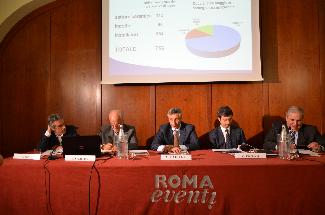 04
Luglio
2013
04
Luglio
2013
Water Efficiency
Water efficiency can bring savings of 405 million euros a year for the public and relaunch the ceramic sanitaryware industry in Italy. An amendment has been presented to bring water saving incentives in line with those for energy
A conference entitled “Water efficiency and building renovation”, organised by Confindustria Ceramica and Unindustria, was held this morning in the Roma Eventi conference hall close to Piazza di Spagna in the centre of Rome. The purpose of the event was to present the Italian water consumption survey conducted by CRESME and to discuss the potential benefits of replacing outdated sanitary fixtures.
The speakers at the conference were Environment Minister Andrea Orlando, Giuseppe Fioroni MP, Francesco Toso from CRESME, entrepreneur Fulvio Spertini, and Armando Cafiero and Antonio Delli Iaconi, Directors-General respectively of Confindustria Ceramica and Unindustria Viterbo.
Minister Andrea Orlando began by noting that construction has been slower to innovate than other economic sectors. “It is vital that tax incentives move away from a vision focusing on individual housing units to one that embraces the entire neighbourhood, where the energy saving measures are rewarded on the basis of a points system,” he argued. “There is a legal vacuum surrounding the so-called “water law” that fails to cover the concept of water saving. This must be filled immediately to ensure that government incentives have the desired effect.”
Giuseppe Fioroni stressed the strategic importance of the Civita Castellana ceramic sanitaryware cluster and noted that parliament is working to raise the incentives from 50% to 65%, at a cost of around 8.5 million euros over 10 years. “Another request we are working on is the legal obligation to install 6-litre flushes in all new buildings, starting with the public sector,” he said.
Francesco Toso discussed the findings of the CRESME survey on sanitary fixtures, which reveals that 75% of the more than 57.6 million WCs installed in Italy are located in residential buildings, with an average of 1.43 WCs per home; 14.6 million are present in other non-residential buildings, including 10% in the public administration. The CRESME survey found that almost 4.4 billion cubic metres of water are consumed each year in Italy in civil buildings, including 1.4 billion cubic metres solely for flushing WCs (to a value of 2.4 billion euro).
Replacing the 10.2 million pre-1970s WCs and installing 6-litre flushes would bring savings of 260 million cubic metres of water each year (equivalent to 405 million euro per year for end consumers) and would cut carbon dioxide emissions deriving from the water cycle by 1.8 million tons.
The introduction of government incentives to replace sanitary fixtures would increase investments by an estimated value of 67.7 million euros, which in turn would boost employment (756 new jobs) and generate revenues for the state of around 13.8 million euro over the two-year period 2013-2014.
Lastly, sanitaryware sector entrepreneur Fulvio Spertini discussed the role of sanitary fixtures in the water efficiency of buildings. He pointed to the positive experience of the city of New York in providing incentives to replace 800,000 WCs, and quoted the figure of average daily household water consumption of 250 litres for each citizen (5 billion cubic metres per year).
“The water saving amendment will serve to extend energy saving incentives to include water,” noted senator Stefano Vaccari. “We hope that the government will now choose to adopt the presented amendment in consideration of the importance and scarcity of this resource.”